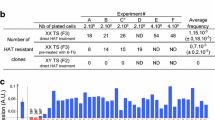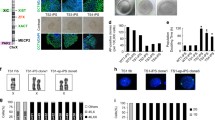Abstract
X-chromosome inactivation was investigated in human chorionic villi in the first trimester of pregnancy and cultured cells established from them. Expression of glucose-6-phosphate dehydrogenase (G6PD) was evaluated in these extraembryonic cells from four females heterozygous for the electrophoretic variants (AB) of G6PD. In each case the uncultured villi as well as derived cultured cells expressed the AB phenotype for G6PD with about equal intensity for the A and B bands. Single-cell-derived clones established from two of the four cases expressed either G6PD A or B. One clone expressing G6PD B was fused with mouse cells, and a hybrid clone retaining the inactive human X chromosome was isolated; there was no evidence of human G6PD expression in this clone retaining an inactive human X. DNA methylation in the first intron of the human gene for hypoxanthine phosphoribosyltransferase (HPRT) was evaluated in the four pairs of cultured villi and fetal cells. No differences were detected between the cultured villi and fetal cells as they all showed bands characteristic of an inactive X from somatic cells. These results show that there is no preferential inactivation of an X in the majority of cells that constitute human tertiary chorionic villi or in cultured cells derived from them. Long-term cultures established from chorionic villi appear to be no different from somatic cells with respect to X-chromosome inactivation.
Similar content being viewed by others
Literature cited
Lyon, M.F. (1961).Nature 190:372–373.
Gartler, S.M., and Riggs, A.D. (1983).Annu. Rev. Genet. 17:155–190.
Takagi, N., and Sasaki, M. (1975).Nature 256:640–642.
Wake, N., Takagi, N., and Sasaki, M. (1976).Nature 262:580–581.
West, J.D., Frels, W.I., Chapman, V.M., and Papaioannou, V.E. (1977).Cell 12:873–882.
Frels, W.I., and Chapman, V.M. (1980).J. Embryol. Exp. Morphol. 56:179–190.
Harper, M.I., Fosten, M., and Monk, M. (1981).J. Embryol. Exp. Morphol. 67:127–135.
Kratzer, P.G., Chapman, V.M., Lambert, H., Evans, R.E., and Liskay, R.M. (1983).Cell 33:37–42.
Ropers, H.H., Wolff, G., and Hitzeroth, H.W. (1978).Hum. Genet. 43:265–273.
Migeon, B.R., and Do, T.T. (1978). InGenetic Mosaics and Chimeras in Mammals, (ed.) Russell, L.B. (Plenum Press, New York), pp. 379–391.
Migeon, B.R., Wolff, S.F., Axelman, J., Kaslow, D.C., and Schmidt, M. (1985).Proc. Natl. Acad. Sci. U.S.A. 82:3390–3394.
Migeon, B.R., Schmidt, M., Axelman, J., and Cullen, C.R. (1986).Proc. Natl. Acad. Sci. U.S.A. 83:2182–2186.
Harrison, K.B., and Warburton, D. (1986).Cytogenet. Cell Genet. 41:163–168.
Mohandas, T., Heinzmann, C., Sparkes, R.S., Wasmuth, J., Edwards, P., and Lusis, A.J. (1985).Somat. Cell Mol. Genet. 12:89–94.
Sparkes, R.S., Baluda, M.C., and Townsend, D.E. (1969).J. Lab. Clin. Med. 73:531–534.
Mohandas, T., Sparkes, R.S., Bishop, D.F., Desnick, R.J., and Shapiro, L.J. (1984).Am. J. Hum. Genet. 36:916–925.
Yen, P.H., Patel, P., Chinault, A.C., Mohandas, T., and Shapiro, L.J. (1984).Proc. Natl. Acad. Sci. U.S.A. 81:1759–1763.
Yen, P.H., Mohandas, T., and Shapiro, L.J. (1986).Somat. Cell Mol. Genet. 12:153–161.
Hunt, P.A., and Jacobs, P.A. (1985).Cytogenet. Cell Genet. 39:1–6.
Migeon, B.R., Wolff, S., Mareni, C., and Axelman, J. (1982).Cell 29:595–600.
Kahan, B., and DeMars, R. (1975).Proc. Natl. Acad. Sci. U.S.A. 72:1510–1514.
Mohandas, T., Sparkes, R.S., Hellkuhl, B., Grzeschik, K.H., and Shapiro, L.J. (1980).Proc. Natl. Acad. Sci. U.S.A. 77:6759–6763.
Kalousek, D.K., Dill, F.J., Pantzar, T., McGillivray, B.C., Yong, S.L., and Wilson, R.D. (1987).Hum. Genet. 77:163–167.
Crane, J.P., and Cheung, S.W. (1988).Prenat. Diagn. 8:119–129.
Author information
Authors and Affiliations
Rights and permissions
About this article
Cite this article
Mohandas, T.K., Passage, M.B., Williams, J.W. et al. X-chromosome inactivation in cultured cells from human chorionic villi. Somat Cell Mol Genet 15, 131–136 (1989). https://doi.org/10.1007/BF01535073
Received:
Revised:
Issue Date:
DOI: https://doi.org/10.1007/BF01535073




